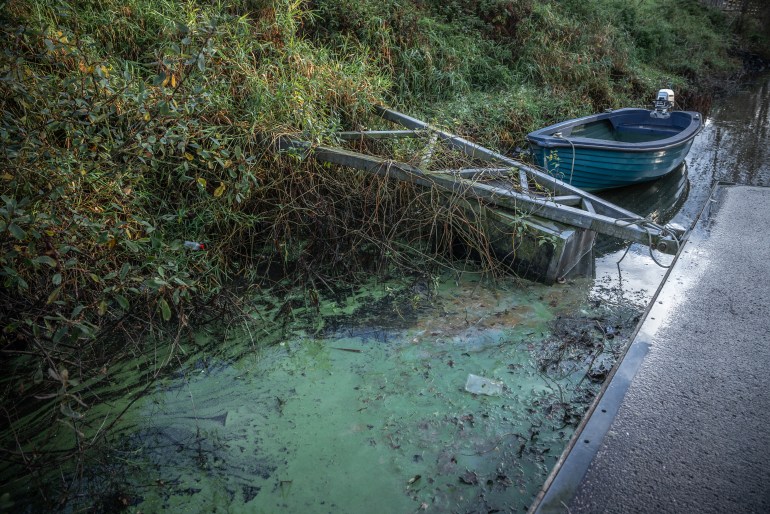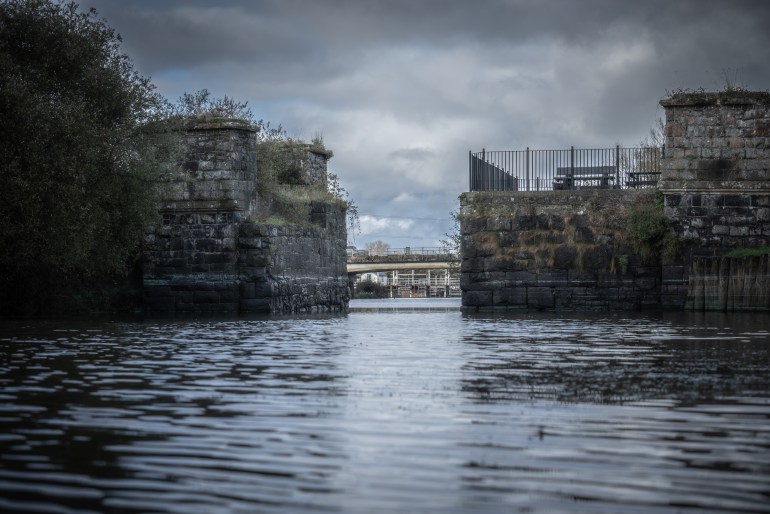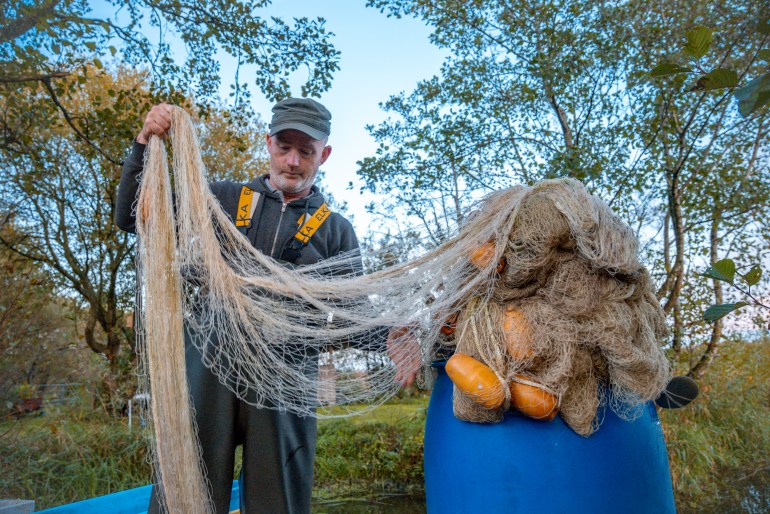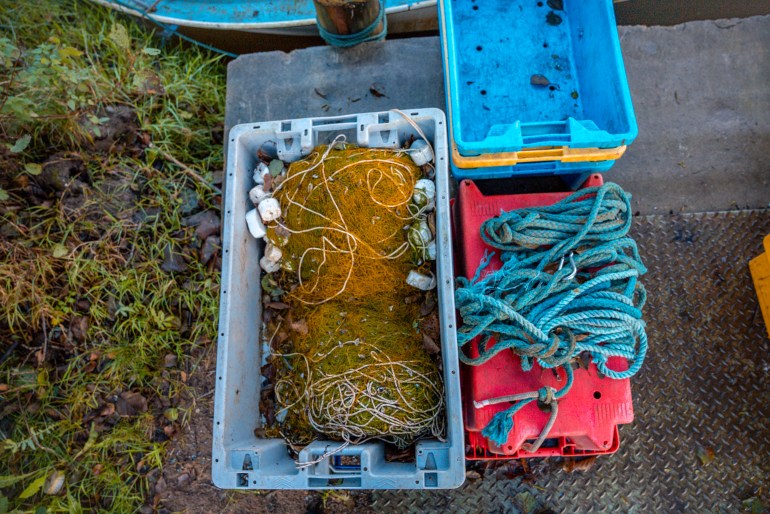On the boarding and the signposts
‘Lough Neagh Fishermen’s Co-operative’.
But ever on our lips and at the weir
‘The eelworks’.
— “Eelworks” by Seamus Heaney

Gerard McCourt is a seventh-generation eel fisherman who works the waters of Lough Neagh [Neill O’Higgins/Al Jazeera]
For Gerard McCourt, there is a lot riding on this year’s eel catch. He should be looking forward to casting his first lines of 2024. However, the 42-year-old McCourt cuts a troubled figure as golden sunshine intermittently punctures the brooding, overcast skyline behind him.
“This year will tell a tale,” he says, with a mix of desperation and agitation in his voice. He talks like a man running on fumes. Dressed in a diesel-flecked grey hoodie, and standing at a jetty along the northern shore of a vast lough (“lake” in Gaelic or Gaeilge, the Irish language), he says that this season will be “make or break” for him and dozens of other fishermen.
Six generations of McCourt’s family have fished for eels here in Lough Neagh, one of the largest freshwater lakes in northwestern Europe. The 400sq km (154sq-mile) lough has been both a muse for Irish artists, poets, and storytellers and a source of deep pride for fishermen who have worked these waters for centuries.
McCourt’s licence was handed down to him by his father – just like the 90 or so other fishermen at Lough Neagh. His boat, which he uses to work the waters at the lough’s south-western end, is also passed down: “Wee Henry” was built by and named after his father. Although not particularly “wee” at around 8 metres (27 feet) long, the burnished black fibreglass vessel is a far cry from the timber rowing boats that lough fishermen used in decades gone by – when eels and other catch were more plentiful.
This is no longer the case. Dwindling numbers of eels compounded by an algal bloom that swept the water body last summer and autumn meant fishermen like McCourt “effectively had to write off” an entire season, he says.
But this drop in eel numbers and dramatic water quality deterioration did not come out of nowhere. In 1983, Lough Neagh’s annual recruitment of juvenile eels (elvers) suddenly plummeted from 8 million to 726,000 – less than 10 percent of what it had been a year beforehand.
And the condition of Northern Ireland’s waterways – many of which feed into the lough system – has been declining for years. In 2021, none of the region’s rivers, lakes, transitional or coastal bodies could be classified as being in “good” health under European water quality legislation.

Last summer, an algal bloom swept the water body, meaning fishermen like McCourt ‘effectively had to write off’ an entire season [Neill O’Higgins/Al Jazeera]
Even before last year’s algal growths, an annual fishing industry report published in April 2023 revealed that the number of elvers “naturally recruited” – and not flown in from the Severn Estuary in England, which has increasingly been the case in recent years – to the lough system was down by approximately half of the previous year’s figure.
This sharp decline in the eel population has also been happening across the rest of Europe. Although the main drivers remain a mystery, many point to climate change.
Adam Mellor, principal scientific officer for the Agri-Food and Biosciences Institute in Northern Ireland (AFBINI), tells Al Jazeera that many complex factors and variables have made it very difficult to pinpoint what is driving the species loss.
He says that despite a “really big body of knowledge” from the fishery itself and the scientists who are studying it, massive gaps in external knowledge are extremely hard to fill. “There’s still a lot of assumption in there,” he adds.
Also, the eels’ breeding cycles, which involve lunar phases and migration to the Sargasso Sea in the Atlantic Ocean, are still not fully understood by scientists, despite recent discoveries.
McCourt speaks of “ecological grief” afflicting fishermen who have for years sensed the major decline in fish and wildlife numbers, which has been validated by recent studies. Growing concerns over continued loss of income and the future viability of commercial fishing at Lough Neagh are only making matters worse, he says.
In 2023, McCourt says, he managed just three weeks in the water during a season that runs from early May to “around Halloween” or the end of October. “I’d definitely have to give up if there isn’t a good catch this May,” he says. “Financially, we couldn’t take another battering like the one we took last year.”
A further collapse in the eel numbers at Lough Neagh could effectively signal the end of commercial fishing at the water body, McCourt adds, given the premium they are sold at when compared with other available fish.
The eels caught in Lough Neagh are almost entirely exported for consumers in London and the Netherlands. Other kinds of fish, which have fared better amid worsening water quality levels at the lough and its tributaries, are not sufficiently valuable to sustain industrial activity. And some species of these “scale fish”, like the pollan (freshwater herring), are considered vulnerable and are heavily protected.
“The scale fish are hardier,” McCourt explains. “They seem to manage better in dirty water. But it’s only a matter of time with the scale fishing, too.”
This is partly because it’s nowhere as lucrative as eel fishing. “If you went out today and came back with eight stone [51kg] of eels, that’s a good catch and you’d be well paid,” McCourt says. Still “you’d need four days a week minimum to make it work financially” – that’s around 800 British pounds [$1,000] per crewperson for the week, including bonuses paid later in the year. At least two people are needed for each fishing boat.
“But with pollan, roach, perch, anything like that, you’d be needing 100 stone [635kg],” McCourt explains, adding that “you’d need massive volumes to make it pay”.
The year 2012 was the last one when McCourt recalls making a profit.

At 400sq km (154sq miles), Lough Neagh is one of the largest freshwater lakes in northwestern Europe [Neill O’Higgins/Al Jazeera]
History of struggle
The economic landscape has been increasingly difficult for fisheries in the United Kingdom and the nearby Republic of Ireland in recent decades – whether at freshwater inland bodies or at sea. But those working at Lough Neagh in Northern Ireland in the UK face another, more pressing, challenge.
For centuries, a bitter dispute played out over public access, denying locals the ability to work the water body. The core issue is ownership: The lough waters are publicly owned, much of the surrounding land is privately held, and the non-water elements of the lough belong to an aristocratic estate. The estate has also claimed ownership of the waters in previous decades and this legacy of disputes has coloured many continuing disagreements.
After a lengthy civil case that contested a Dutch-British consortium’s claim to exclusive fishing rights on the water body, the Lough Neagh Fishermen’s Co-Operative – now Europe’s largest remaining wild eel fishery – was formed in 1965 to represent the interests of local fishermen and oversee the lough’s fishing rights, which it acquired from the company in the early 1970s. But to this day, rent is still paid to the Earl of Shaftesbury’s estate for the right to fish.
The grip of private interests on the lough’s fishing communities continues to be felt keenly by Gary McErlain, who speaks to me by the shores of Traad, a small peninsula along the lough’s northwest corner. Unfurling a traditional long and bag-shaped fishing net, he says he feels wounded by the recently declared stance of Earl Nicolas Ashley-Cooper that he would not consider gifting the lough to the community.
The Shaftesbury Estate also receives royalty fees for industrial sand extraction, which is scarring the lough bed and creating “dead zones” for fish, according to the fishermen.
McErlain, 49, is one of a number of practising fishermen whose families were disenfranchised by the absentee landlord’s territorial claim, which dates back to the Plantation of Ulster in the early 1600s. His grandfather was “criminalised”, McErlain says, for trying to “make a living on Lough Neagh doing what their family had done before them”.
For decades, fishermen had their lines confiscated and their boats rammed by bailiffs acting for the consortium. McErlain’s grandfather was one of many prosecuted for trespassing. Courthouses in many of the market towns right around Lough Neagh were termed “‘fishermen’s courts’ because there were so many fishermen that went through them”, McErlain explains, stressing “that was the scale of it.”
Even with the transfer of fishing rights, those convictions — likely hundreds of them — have never been overturned.

Gary McErlain, whose grandfather was prosecuted in the 1970s for trespassing for fishing the lough, is upset by the Earl of Shaftesbury’s decision not to give the water body to the community [Neill O’Higgins/Al Jazeera]
Dying way of life?
Today, fishing families around the lough still say that eel fishing and the water body itself is “in the blood”.
But they feel their concerns have been largely unheard or ignored by politicians and authorities. Alongside their current economic woes, fishermen feel longer-term planning for the industry’s survival has not been adequate.
With the return of Northern Ireland’s devolved government earlier this month, following a two-year hiatus of its power-sharing arrangements, there is considerable pressure on political leaders to address Lough Neagh’s devastated condition. A departmental report with 113 recommendations on how to “save” the water body is expected in the coming weeks.
Lough Neagh fishermen are not optimistic, however, after what McErlain describes as a “non-existent” government response to 2023’s algae crisis. McCourt agrees, adding that “nothing is really being done on the ground”.
John Spence, a retired researcher specialising in aquatic systems management, says there have been some “welcome” noises and recent moves from politicians starting to grapple with Lough Neagh’s many problems. One proposal: Establish a cross-departmental body and a new management structure to protect the lough.
But he believes that “no substantive progress” has been made to date and that the inefficacy of Northern Ireland’s devolved administration means expert oversight will be required from other jurisdictions.
“It’s going to take a long time before they get to grips with what the real structural issues are,” he says. “The situation needs outside observation. Unfortunately, the current Westminster government doesn’t seem prepared to play that role.
“One logical way of addressing all of this would be to involve the Irish government in water management since Lough Neagh and other major water bodies in the North are transboundary. This was contemplated in the [1998] Good Friday Agreement [signed by the UK and the Republic of Ireland], but hasn’t yet been implemented.”
Meanwhile, many fishermen at the lough have been forced to double-job or give up altogether.
McCourt and McErlain now supplement their incomes to remain afloat. But some of the lough’s outspoken former eel fishermen, like 53-year-old Declan Coney, say worsening conditions – and, in Coney’s case, the death of his father, his fishing partner – are forcing them to quit, as Coney did in 2000.
At times appearing wary and diffident, Coney clearly expresses his love of the lough’s wildlife when he speaks, often trailing off into detailed descriptions of wildfowl such as bittern, which are now extinct at Lough Neagh. Even when he talks about the job’s low-paying off-season work, straining to meet catch quotas in the cold darkness, and hunting for worms in nearby fields, a fondness for his former livelihood creases his worn face.
But Coney’s nostalgia is tempered with a deep disappointment at a perceived lack of support from the co-op and government. “Growing up,” he says, “it was like, ‘I want to be a fisherman.’ And then when you got that opportunity, it was like, ‘Great. I’ve made it – I’ve reached my goal’. And then it was so frustrating feeling like there was no one there to help you.”
Coney says the progressive decline of the lough’s fishing industry since the 1980s has unravelled the ties that bind the shoreline’s tight-knit communities together. Soon, he says, the only evidence of Lough Neagh’s fishing industry will be “nothing more than an artefact” in a museum.
Recruitment is increasingly a problem, he added, with the vast majority of Lough Neagh fishermen above the age of 40. “There are no jobs to keep young people by the loughshore. And so all that local knowledge is being lost – there’s no one for fishermen to pass it onto now.”

Fishing nets at Lough Neagh [Neill O’Higgins/Al Jazeera]
Future survival
Researchers say it is too early to know the full ecological impacts of last year’s algal bloom. But, facing the prospect of sectoral collapse, fishermen at the lough say they do not have time on their side.
There has been no coordinated campaign group advocating for the compensation of lost earnings among Lough Neagh fishermen. And no estimate has been put on what that potential bill could amount to.
But fishermen are exploring avenues of legal redress, according to Enda McGarrity, a solicitor from PA Duffy & Co. The local outfit’s founder Paddy Duffy “was instrumental in setting up the Lough Neagh Fishermen’s Co-operative in the 1960s with the intention of protecting the livelihoods of fishermen in the area,” he explained.
McGarrity said the firm has been “instructed to explore legal remedies in relation to the current pollution issues in Lough Neagh” in tandem with the fishermen. A number of cases are expected to be filed over the coming months.
Meanwhile, some believe a year or two of fishing inactivity, alongside a moratorium across other forms of commercial activity, may hold the key to restoring fish stocks.
However, AFBINI researchers tell Al Jazeera that ecosystem modelling work – field-based data maps that provide an evidence base for future policy – would be needed before taking such drastic action. These models can take many months and sometimes years to produce.
“What we’re discovering is that, if somebody were to, say, stop fishing for three years, we don’t necessarily have a good enough understanding of what the response would be,” Mellor says.
His colleague, Kevin Gallagher, points out that a complete cessation of fishing activity could have unintended negative consequences on the lough system. For example, it could allow invasive fish species numbers to multiply and become unmanageable.
“If you don’t control the invasives, you don’t know what kinds of impacts there could be on the conservation species – the pollan and trout. So it could have adverse knock-on effects.”
“Stopping a fishery is obviously going to help whatever fish are being targeted,” Mellor says, adding that there’s no clear picture of how that balances out. “The social and economic impacts of closing a fishery, even temporarily, would also need to be weighed against any scientific evidence base to suggest such a decision is worth considering.”
AFBINI scientists say that a fundamental shift in land management practices alongside targeted actions on the lough’s waters are key to safeguarding the fishery’s future.
“Fishing isn’t causing the problem,” Gallagher says. “Sand extraction is to a degree.” He also cites some farmers’ excess use of fertiliser.
Mellor also points to non-agricultural challenges. “There are more than twice the UK average of septic tanks in that catchment”, he says, with many unlikely to be serviced every year or have their outputs checked regularly.
He warns that locals may also have to adjust their expectations about what kind of recovery can be achieved at Lough Neagh. “Fundamentally, we have to recognise that we won’t be going back to a baseline that we had five, 20 or 30 years ago,” he says. “We can’t change locally the effects of a changing climate.”
However, he adds, “we can manage some aspects” like fisheries, nutrient inputs, and extraction activity.
Timelines on the lough’s recovery are being set at decades – ranging from 20 to 40 years, depending on different kinds of estimations and metrics.
But, for McErlain and others like him who still work the lough’s mythical waters, these questions are not academic. Their livelihoods, he says, depend on stronger data, robust environmental governance and a just financial settlement for fishermen.

Fishing gear at Lough Neagh [Neill O’Higgins/Al Jazeera]
News Related-
Recall Just Announced For Popular Cookies Featured In Holiday Gift Baskets
-
Eagles rally past Bills in overtime as Chiefs win
-
Reality bites the green energy agenda
-
Sandigan orders Marcos Sr. pal to pay workers
-
DSWD: Shear line, LPA affect 1.2 million people; over 18,000 families evacuated
-
The mayor of Paris is making a loud exit from X, calling the platform a 'gigantic global sewer'
-
Rain showers, thunderstorms over Luzon, including Metro Manila — Pagasa
-
'Naruto' live-action film adaptation is in the works
-
NASA Highlights Stingray Nebula
-
Manila's Lagusnilad underpass opens
-
China probes debt-ridden financial giant
-
China's VUCA situation
-
Unraveling the mystery that is diabetes
-
Bangladesh's nuke plant is not going to steal PH investments
